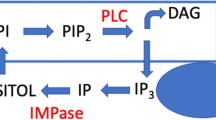Summary
The effect of TTX (infused during brain dialysis of the striatum and nucleus accumbens) on the in vivo release of dopamine, 3,4-dihydroxyphenylacetic acid and homovanillic acid, was investigated. In addition it was studied whether the increase in the release of dopamine, induced by various pharmacological treatments, was sensitive to TTX infusion. The following drugs were studied: haloperidol, amphetamine, haloperidol co-administered with GBR 12909, morphine and MPP+. Dialysis was carried out in the striatum, except for morphine, which was studied in the nucleus accumbens. The infusion of TTX revealed three different types of pharmacologically enhanced dopamine release in conscious rats. First, action potential dependent dopamine release (exocytosis), which was observed in untreated animals as well as in animals treated with haloperidol, haloperidol + GBR 12909, and morphine. Second, action potential independent release (carrier-mediated) was established in the case of amphetamine. Third, action potential independent DA release, probably caused by neurotoxic reactions was observed during MPP+ infusion.
Similar content being viewed by others
References
Bunney BS, Walters JR, Roth RH, Aghajanian GK (1973) Dopaminergic neurons: effect of antipsychotic drugs and amphetamine on single cell activity. J Pharmacol Exp Ther 185:560- 571
Imperato A, Di Chiara G (1984) Trans-striatal dialysis coupled to reverse phase high performance liquid chromatography with electrochemical detection: a new method for the study of the in vivo release of endogeneous dopamine and metabolites. J Neurosci 4:966–977
Imperato A, Di Chiara G (1985) Dopamine release and metabolism in awake rats after systemic neuroleptics as studied by trans-striatal dialysis. J Neurosci 5:297–306
Imperato A, Mulas A, Di Chiara G (1986) Opposite effects on u and k opiate agonists on dopamine release in the nucleus accumbens of freely moving rats. In: Biggio G, Spano PF, Toffano G, Gessa GL (eds) Modulation of central and peripheral transmitter function. Liniana Press, Padova, pp 513–517
Kehr W, Carlsson A, Lindqvist M, Magnusson T, Atack CV (1972) Evidence for a receptor-mediated feedback control of striatal tyrosine hydroxylase activity. J Pharm Pharmacol 24:744–747
König JFR, Klippel RA (1963) The rat brain: A stereotaxic atlas of the forebrain and lower parts of the brainstem. Williams and Wilkins, Baltimore, p 162
Korf J, Venema K (1985) Amino acids in rat striatal dialysates: methodological aspects and changes after electroshock. J Neurochem 45:1341–1348
Kuczenski R (1983) Biochemical actions of amphetamine and other stimulants. I Creese I (ed) Stimulants: neurochemical, behavioral and clinical perspectives. Raven Press, New York, pp 31–61
Narahashi T (1974) Chemical tools in the study of excitable membranes. Physiol Rev 54:813–889
Nicklas WJ, Vyas I, Heikkila RE (1985) Inhibition of NADH-linked oxidation in brain mitochondria by 1-methyl-4-phenyl-pyridine, a metabolite of the neurotoxin 1-methyl-4-phenyl-1,2,5,6-tetrahydropyridine. Life Sci 36:2503–2508
Niddam R, Arbilla S, Scatton B, Dennis T, Langer SZ (1985) Amphetamine induced release of endogenous dopamine in vitro is not reduced following pretreatment with reserpine. Naunyn-Schmiedeberg's Arch Pharmacol 329:123–127
Parker EM, Cubbedu LV (1986a) Effects of d-amphetamine and dopamine synthesis inhibitors on dopamine and acetylcholine neurotransmission in the striatum. I. Release in the absence of vesicular transmitter stores. J Pharmacol Exp Ther 237:179–192
Parker EM, Cubbedu LV (1986b) Effects of d-amphetamine and dopamine synthesis inhibitors on dopamine and acetylcholine neurotransmission in the striatum. II. Release in the presence of vesicular transmitter stores. J Exp Ther 237:193–203
Ramsay RR, Dadgar J, Trevor A, Singer TP (1986) Energy-driven uptake of N-methyl-4-phenylpyridine by brain mitochondria mediates the neurotoxicity of MPTP. Life Sci 39:581–588
Rollema H, Damsma G, Horn AS, De Vries JB, Westerink BHC (1986) Brain dialysis in conscious rats reveals an instantaneous massive release of striatal dopamine in response to MPP+. Eur J Pharmacol 126:345–346
Rollema H, De Vries JB, Damsma G, Westerink BHC, Kranenborg GL, Kuhr WG, Horn AS (1987) The use of in vivo brain dialysis of dopamine, acetylcholine, amino acids and lactic acid in studies on the neurotoxin MPTP. Toxicology (in press)
Roth RH, Murrin LC, Walters J (1976) Central dopaminergic neurons: effects of alterations in impulse flow on the accumulation of dihydroxyphenylacetic acid. Eur J Pharmacol 36:163–171
Shore PA (1976) Actions of amfonelic acid and other nonamphetamine stimulants on the dopamine neuron. J Pharm Pharmacol 28:855–858
Westerink BHC, Mulder TBA (1981) Determination of picomole amounts of dopa, noradrenaline, dopamine, 3,4-dihydroxyphenylacetic acid, homovanillic acid, and 5-hydroxyindolacetic acid in nervous tissue after one-step purification on Sephadex G 10, using high-performance liquid chromatography with a novel type of electrochemical detection. J Neurochem 36:1449–1462
Westerink BHC, Spaan SJ (1982) On the significance of endogenous 3-methoxytyramine for the effects of centrally acting drugs on dopamine metabolism in the rat brain. J Neurochem 38:680–686
Westerink BHC, Tuinte MHJ (1986) Chronic use of intracerebral dialysis for the in vivo measurement of 3,4-dihydroxyphenylethylamine and its metabolite 3,4-dihydroxyphenylacetic acid. J Neurochem 46:181–185
Westerink BHC, Damsma G, de Vries JB, Koning H (1987) Dopamine reuptake inhibitors show inconsistent effects on the in vivo release of dopamine as measured by intrastriatal dialysis in the rat. Eur J Pharmacol 135:123–128
Zetterström T, Ungerstedt U (1984) Effect of apomorphine on the in vivo release of dopamine and its metabolites studied by intracerebral dialysis. Eur J Pharmacol 97:29–36
Zetterström T, Sharp T, Marsden CA, Ungerstedt U (1983) In vivo measurement of dopamine and its metabolites by intracerebral dialysis: changes after d-amphetamine. J Neurochem 41:1769–1773
Zetterström T, Sharp T, Ungerstedt U (1984) Effect of neuroleptic drugs on striatal dopamine release and metabolism in the awake rat studied by intracerebral dialysis. Eur J Pharmacol 106:27–37
Author information
Authors and Affiliations
Additional information
Send offprint requests to B. H. C. Westerink
Rights and permissions
About this article
Cite this article
Westerink, B.H.C., Tuntler, J., Damsma, G. et al. The use of tetrodotoxin for the characterization of drug-enhanced dopamine release in conscious rats studied by brain dialysis. Naunyn-Schmiedeberg's Arch Pharmacol 336, 502–507 (1987). https://doi.org/10.1007/BF00169306
Received:
Accepted:
Issue Date:
DOI: https://doi.org/10.1007/BF00169306




